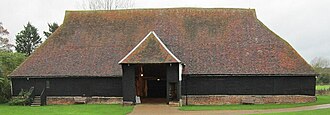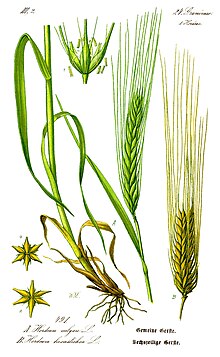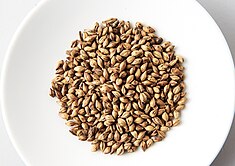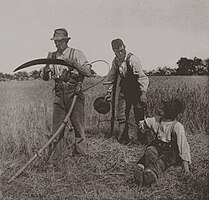Barley
| Barley | |
|---|---|

| |
| Scientific classification | |
| Kingdom: | Plantae |
| Clade: | Tracheophytes |
| Clade: | Angiosperms |
| Clade: | Monocots |
| Clade: | Commelinids |
| Order: | Poales |
| Family: | Poaceae |
| Subfamily: | Pooideae |
| Genus: | Hordeum |
| Species: | H. vulgare
|
| Binomial name | |
| Hordeum vulgare | |
| Synonyms[2] | |
|
List
| |
Barley (Hordeum vulgare), a member of the
In 2022, barley was fourth among grains in quantity produced, 155 million tonnes, behind maize, wheat, and rice. Globally 70% of barley production is used as animal feed, while 30% is used as a source of fermentable material for beer, or further distilled into whisky, and as a component of various foods. It is used in soups and stews, and in barley bread of various cultures. Barley grains are commonly made into malt in a traditional and ancient method of preparation. In English folklore, John Barleycorn personifies the grain, and the alcoholic beverages made from it. English pub names such as The Barley Mow allude to barley's role in the production of beer.
Etymology

The Old English word for barley was bere.[4] This survives in the north of Scotland as bere; it is used for a strain of six-row barley grown there.[5] Modern English barley derives from the Old English adjective bærlic, meaning "of barley".[3][6] The word barn derives from Old English bere-aern meaning "barley-store".[3] The name of the genus is from Latin hordeum, barley, likely related to Latin horrere, to bristle.[7]
Description

Barley is a
The genome of barley was sequenced in 2012 by the International Barley Genome Sequencing Consortium and the UK Barley Sequencing Consortium.[10] The genome is organised into seven pairs[11] of nuclear chromosomes (recommended designations: 1H, 2H, 3H, 4H, 5H, 6H and 7H), and one mitochondrial and one chloroplast chromosome, with a total of 5000 Mbp.[12] Details of the genome are freely available in several barley databases.[13]
Origin
External phylogeny
The barley
| (Part of Poaceae) | |
Domestication

Barley was one of the
Domestication changed the
The wild barley found currently in the Fertile Crescent may not be the progenitor of the barley cultivated in Eritrea and Ethiopia, indicating that it may have been domesticated separately in eastern Africa.[27]
Spread

Archaeobotanical evidence shows that barley had spread throughout Eurasia by 2,000 BC.
| jt barley determinative/ideogram |
| ||||
| jt (common) spelling |
| ||||
| šma determinative/ideogram |
|
Rations of barley for workers appear in
Taxonomy and varieties
Two-row and six-row barley
Spikelets are arranged in triplets which alternate along the rachis. In wild barley (and other Old World species of Hordeum), only the central spikelet is fertile, while the other two are reduced. This condition is retained in certain cultivars known as two-row barleys. A pair of mutations (one dominant, the other recessive) result in fertile lateral spikelets to produce six-row barleys.[9] A mutation in one gene, vrs1, is responsible for the transition from two-row to six-row barley.[41]
In traditional taxonomy, different forms of barley were classified as different species based on morphological differences. Two-row barley with shattering spikes (wild barley) was named Hordeum spontaneum (K. Koch). Two-row barley with nonshattering spikes was named as H. distichon (L.), six-row barley with nonshattering spikes as H. vulgare L. (or H. hexastichum L.), and six-row with shattering spikes as H. agriocrithon Åberg. Because these differences were driven by single-gene mutations, coupled with cytological and molecular evidence, most recent classifications treat these forms as a single species, H. vulgare L.[9]
-
6-row barley has three fertile spikelets per cluster
-
Two-row and six-row
Hulless barley
Hulless or "naked" barley (Hordeum vulgare L. var. nudum Hook. f.) is a form of domesticated barley with an easier-to-remove hull. Naked barley is an ancient food crop, but a new industry has developed around uses of selected hulless barley to increase the digestibility of the grain, especially for pigs and poultry.[42] Hulless barley has been investigated for several potential new applications as whole grain, bran, and flour.[43]
| Barley production – 2022 | |
|---|---|
| Country | Millions of tonnes |
| 23.4 | |
| 14.4 | |
| 11.3 | |
| 11.2 | |
| 10.0 | |
| 8.5 | |
| 7.4 | |
| 7.0 | |
| World | 154.9[44] |
Production
In 2022, world production of barley was 155 million tonnes, led by Russia accounting for 15% of the world total (table). France, Germany, and Canada were secondary producers. Worldwide barley production was fourth among grains, following maize (1.2 billion tonnes), wheat (808 million tonnes), and rice (776 million tonnes).[45]
Cultivation
Barley is a crop that prefers relatively low temperatures, 15 to 20 °C in the growing season; it is grown around the world in temperate areas. It grows best in well-drained soil in full sunshine. In the tropics and subtropics, it is grown for food and straw in South Asia, North and East Africa, and in the Andes of South America. In dry regions it requires irrigation.[46] It has a short growing season and is relatively drought-tolerant.[40] Barley is more tolerant of soil salinity than other cereals, varying in different cultivars.[47] It has less winter-hardiness than winter wheat and far less than rye.[48]
Like other cereals, barley is typically planted on tilled land. Seed was traditionally scattered, but in developed countries is usually drilled. As it grows it requires soil nutrients (nitrogen, phosphorus, potassium), often supplied as fertilizers. It needs to be monitored for pests and diseases, and if necessary treated before these become serious. The stems and ears turn yellow when ripe, and the ears begin to droop. Traditional harvesting was by hand with sickles or scythes; in developed countries, harvesting is mechanised with combine harvesters.[46]
-
Young winter barley in early November,
Scotland, 2009 -
Spraying barley for rust fungus,
New Zealand, 1979 -
Harvesting winter barley with a combine harvester, Germany, 2017
Pests and diseases
Among the insect pests of barley are
Serious fungal diseases of barley include powdery mildew caused by Blumeria graminis, leaf scald caused by Rhynchosporium secalis, barley rust caused by Puccinia hordei, crown rust caused by Puccinia coronata, various diseases caused by Cochliobolus sativus, Fusarium ear blight,[49] and stem rust (Puccinia graminis).[50] Bacterial diseases of barley include
For durable disease resistance,
-
Wireworms, the larvae of click beetles, kill barley seedlings.
-
Barley rust, a disease caused by the fungus Puccinia hordei
Food
 | |
| Nutritional value per 100 g (3.5 oz) | |
|---|---|
| Energy | 515 kJ (123 kcal) |
28.2 g | |
| Sugars | 0.3 g |
| Dietary fiber | 3.8 g |
0.4 g | |
2.3 g | |
Niacin (B3) | 13% 2.063 mg |
| Pantothenic acid (B5) | 3% 0.135 mg |
| Vitamin B6 | 7% 0.115 mg |
| Folate (B9) | 4% 16 μg |
| Vitamin B12 | 0% 0 μg |
| Choline | 2% 13.4 mg |
| Vitamin C | 0% 0 mg |
| Vitamin D | 0% 0 IU |
| Vitamin E | 0% 0.01 mg |
| Vitamin K | 1% 0.8 μg |
Copper | 12% 0.105 mg |
| Iron | 7% 1.3 mg |
| Magnesium | 5% 22 mg |
| Manganese | 11% 0.259 mg |
| Phosphorus | 4% 54 mg |
| Potassium | 3% 93 mg |
| Sodium | 0% 3 mg |
| Zinc | 7% 0.82 mg |
| Other constituents | Quantity |
| Water | 68.8 g |
| Cholesterol | 0 mg |
| †Percentages estimated using US recommendations for adults,[57] except for potassium, which is estimated based on expert recommendation from the National Academies.[58] | |
Preparation
Hulled barley (or covered barley) is eaten after removing the inedible, fibrous, outer husk or hull. Once removed, it is called dehulled barley (or pot barley or scotch barley).[59] Pearl barley (or pearled barley) is dehulled to remove most of the bran, and polished.[59] Barley meal, a wholemeal barley flour lighter than wheat meal but darker in colour, is used in gruel.[59] This gruel is known as سويق : sawīq in the Arab world.[60]
With a long history of cultivation in the
In
The six-row variety
In
-
Barley grains with and without the outer husk
-
bannock, Orkney, 2008
-
Mugimeshi, Japanese steamed barley rice
-
Keşkek, a Middle Eastern barley stew
Nutrition
Cooked barley is 69% water, 28%
Health implications
According to
Eating whole-grain barley, a high-fibre grain, improves regulation ofUses
Beer, whisky, and soft drinks
Barley, made into
Nonalcoholic drinks such as
-
Traditionalfloor malting in Scotland for malt whisky
-
Barley grains being mashed (heated with water) for brewing beer
-
Scotch whisky and beer are both made from barley.
-
Boricha, Korean
roasted barley tea
Animal feed

Some 70% of the world's barley production is used as livestock feed,[80] for example for cattle feeding in western Canada.[81] In 2014, an enzymatic process was devised to make a high-protein fish feed from barley, suitable for carnivorous fish such as trout and salmon.[82]
Other uses
Barley straw has been placed in mesh bags and floated in fish ponds or water gardens to help prevent algal growth without harming pond plants and animals. The technique's effectiveness is at best mixed.[83] Barley grains were once used for measurement in England, there being nominally three or four barleycorns to the inch.[84] By the 19th century, this had been superseded by standard inch measures.[85] In ancient Mesopotamia, barley was used as a form of money, the standard unit of weight for barley, and hence of value, being the shekel.[86]
Culture and folklore
In English folklore, the figure of
English pub names such as The Barley Mow,[90] John Barleycorn,[87] Malt Shovel,[91] and Mash Tun[92] allude to barley's role in the production of beer.[90]
-
Porcelain figurine of John Barleycorn, complete with songsheet and little brown jug of beer
-
English pub names such as The Barley Mow (like this pub at Clifton Hampden) allude to the use of barley to make the beer available inside.[90]
References
- ^ "Hordeum vulgare". Integrated Taxonomic Information System.
- ^ "Hordeum vulgare L." The Plant List: A Working List of All Plant Species. Archived from the original on 8 April 2020. Retrieved 2 February 2016.
- ^ ISBN 978-0-415-02647-5.
barley water was used.
- ^ Clark Hall, J. R. (2002) [1894]. "bere". A Concise Anglo-Saxon Dictionary (4th ed.). University of Toronto Press. p. 43.
- ^ "Dictionary of the Scots Language: "DSL - DOST Bere, Beir"". Archived from the original on 26 May 2011. Retrieved 19 November 2008.
- ISBN 978-0-19-861186-8.
- ^ "hordeum noun". Merriam-Webster. Retrieved 13 January 2024.
- ^ "Hordeum vulgare — common barley". Native Plant Trust. Retrieved 13 January 2024.
- ^ ISBN 978-0-19-850357-6.
- PMID 23075845.
- ^ OCLC 162130976.
- ^ mapview. "barley genome at ncbi.nlm.nih.gov". Archived from the original on 29 October 2004. Retrieved 6 October 2014.
- ^ "Background: The barley genome". UK Barley Sequencing Consortium. 2024. Retrieved 12 January 2024.
- hdl:11336/25248.
- ^ PMID 30020920.
- PMID 10742042.
- S2CID 11574248.
- PMID 23033493.
- S2CID 162019976.
Traces of starch found on a large flat stone discovered in the hunter-fisher-gatherer site of Ohalo II famously represent the first identification of Upper Palaeolithic grinding of grasses. Given the importance of this discovery for the use of edible grain, further analyses have now been undertaken. Meticulous sampling combined with good preservation allow the authors to demonstrate that the Ohalo II stone was certainly used for the routine processing of wild cereals, wheat, barley and now oats among them, around 23 000 years ago.
- PMID 26200895.
- ISBN 978-0-202-36557-2.
This feature allows us to describe the Jarmo barley as the earliest "domesticated" two-row barley yet found.
- JSTOR 40273219.
- PMID 30868647.
- PMID 29712833.
- PMID 25812037.
- S2CID 31695204.
- ^ "Maanviljely levisi Suomeen Itä-Aasiasta jo 7000 vuotta sitten - Ajankohtaista - Tammikuu 2013 - Humanistinen tiedekunta - Helsingin yliopisto" (in Finnish). Archived from the original on 6 October 2014. Retrieved 6 October 2014.
- S2CID 163060564.
- S2CID 6245657. Retrieved 25 August 2016.
- ^ "IIT KGP Researchers say Indus Valley civilization in India is older than thought before". iitkgp.org. IIT Kharagpur. Archived from the original on 18 September 2016. Retrieved 25 August 2016.
- ^ ISBN 978-1-56025-871-1.
- ISBN 978-0-7141-1705-8.
- ISBN 0-521-29037-6.
- OCLC 936727983.
Demeter's name, therefore, could be interpreted in Greek to mean 'barley-mother'
- ISBN 978-0-8342-1767-6.
- Natural History, xviii.72.
- ISBN 978-0-7432-1650-0.
- ISBN 978-0-7656-1354-7.
- ^ a b McGee 1986, p. 235
- PMID 17220272.
- .
- .
- FAOSTAT, UN Food and Agriculture Organization, Corporate Statistical Database. 2024. Retrieved 12 January 2024.
- ^ "Comparison of world production values in 2022; maize-wheat-rice-barley". FAOSTAT, UN Food and Agriculture Organization, Corporate Statistical Database. 2024. Retrieved 12 January 2024.
- ^ a b c "Barley". PlantVillage (PennState University). Retrieved 14 January 2024.
- PMID 24004485.
- ^ "Winter-hardiness". Stockinger Lab, Ohio State University. Retrieved 14 January 2024.
- .
- .
- ^ Mathre, D. E. (1997). Compendium of barley diseases. American Phytopathological Society. p. 120.
- ^ Brunt, A. A.; Crabtree, K.; Dallwitz, M. J.; Gibbs, A. J.; Watson, L.; Zurcher, E. J., eds. (20 August 1996). "Plant Viruses Online: Descriptions and Lists from the VIDE Database". Archived from the original on 18 October 2006.
- ^ "Barley mild mosaic bymovirus". Archived from the original on 8 December 2006.
- .
- PMID 12923305.
- PMID 22568813.
- ^ United States Food and Drug Administration (2024). "Daily Value on the Nutrition and Supplement Facts Labels". Retrieved 28 March 2024.
- )
- ^ a b c Simon, André (1963). Guide to Good Food and Wines: A Concise Encyclopedia of Gastronomy Complete and Unabridged. London: Collins. p. 150.
- ISBN 978-0-88706-344-2.
- ISBN 978-0-313-32021-7.
- ^ Marks, Gil (2010). "Cholent/Schalet". Encyclopedia of Jewish Foods. HMH. p. 40.
- ISBN 978-0-309-04990-0. Retrieved 25 July 2008.
- ^ Martin, Peter; Chang, Xianmin (June 2008). "Bere Whisky: rediscovering the spirit of an old barley". The Brewer & Distiller International. 4 (6): 41–43. Archived from the original on 1 December 2008. Retrieved 14 November 2008.
- .
- . Retrieved 11 January 2024.
- ^ USDA Database entry Accessed 14 January 2024.
- US Food and Drug Administration. 22 May 2006. Retrieved 2 December 2015.
- ^ "Summary of Health Canada's Assessment of a Health Claim about Barley Products and Blood Cholesterol Lowering". Health Canada. 12 July 2012. Retrieved 2 December 2015.
- S2CID 29100975.
- PMID 25225349.
- PMID 25789300.
- PMID 22237879.
- ^ a b McGee 1986, p. 490
- ISBN 978-0-15-101012-7.
and six-row barley was traditionally used in US beers.
- ^ McGee 1986, p. 481
- ^ McGee 1986, p. 471
- ISBN 978-1-85166-103-9.
- ^ "Caffè d'orzo: il caffè senza caffeina" [Barley Coffee: Coffee without Caffeine]. cibo360 (in Italian). Retrieved 13 January 2024.
- ^ Akar, Taner; Avci, Muzaffer; Dusunceli, Fazil (15 June 2004). "Barley: Post-Harvest Operations" (PDF). Food and Agriculture Organization. Archived (PDF) from the original on 21 January 2022.
- ^ "Corn or Barley for Feeding Steers?". Government of Ontario. Archived from the original on 20 December 2006. Retrieved 6 October 2014.
- ^ Avant, Sandra (14 July 2014). "Process Turns Barley into High-protein Fish Food". USDA Agricultural Research Service. Retrieved 9 September 2014.
- ^ Lembi, Carole A. "Barley straw for algae control" (PDF). Department of Botany and Plant Pathology, Purdue University, West Lafayette, Indiana. Archived from the original (PDF) on 8 April 2003.
- ^ "Barleycorn". Collins Dictionary. 2023. Retrieved 18 September 2023.
- ^ George Long (1842). "Standard Measure, Weight". The Penny Cyclopædia of the Society for the Diffusion of Useful Knowledge. Vol. 26, Ungulata–Wales. C. Knight. p. 436.
- JSTOR 3632646.
- ^ ISBN 978-0-7204-8021-4.
- ^ "John Barleycorn Must Die". University of Arkansas Press. Archived from the original on 14 January 2024. Retrieved 14 January 2024.
- ^ Sharp, Cuthbert (1834). "The Bishoprick Garland or a Collection of Legends, Songs, Ballads, &c". Universitas Studii Salamantini. p. 48. Retrieved 15 January 2024.
- ^ a b c "A history of British pub names". The History Press. Retrieved 30 December 2023.
- Lynn Advertiser. 19 March 1870. p. 8.
- ^ "The Mash Tun: Brighton's Beating Heart". Mash Tun. Retrieved 13 January 2024.
Sources
- McGee, Harold (1986). On Food and Cooking: The Science and Lore of the Kitchen. Unwin. ISBN 978-0-04-440277-0.


















![English pub names such as The Barley Mow (like this pub at Clifton Hampden) allude to the use of barley to make the beer available inside.[90]](http://upload.wikimedia.org/wikipedia/commons/thumb/e/e7/The_Barley_Mow%2C_Clifton_Hampden_%28wide%29.jpg/275px-The_Barley_Mow%2C_Clifton_Hampden_%28wide%29.jpg)
